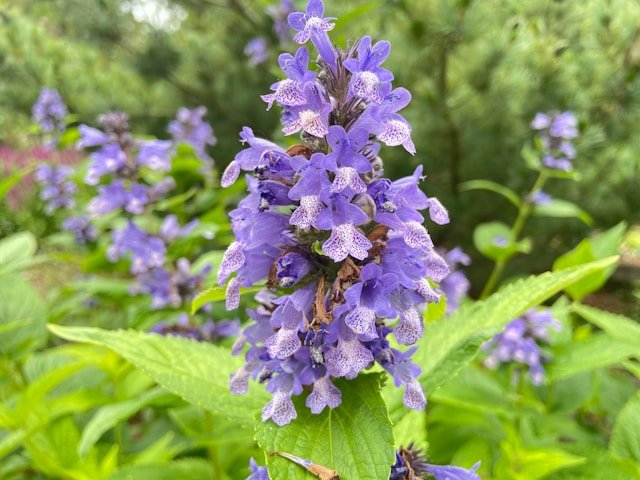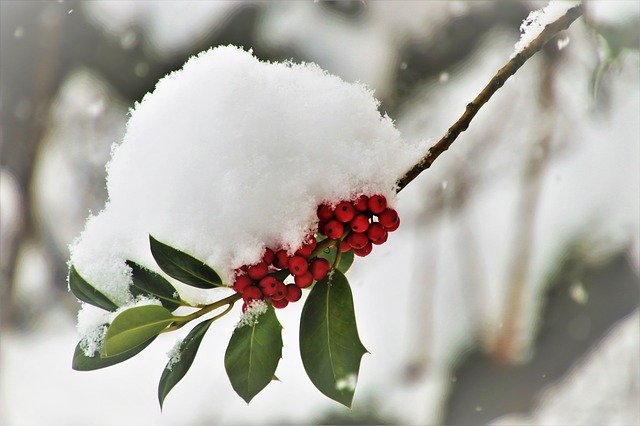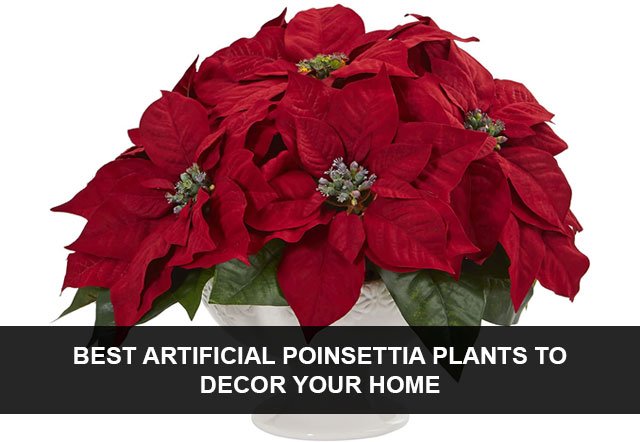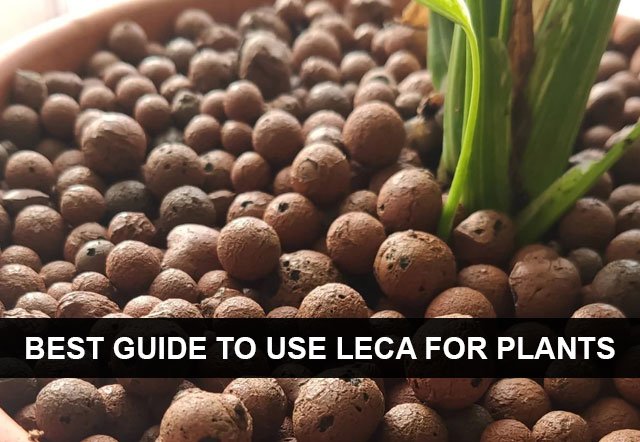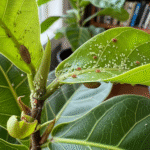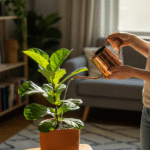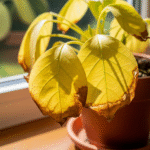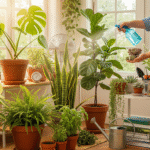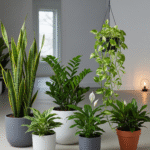In botanical beauty effects, there are few shades that have the same grandeur look and the charm as the intensified violet colors. Though perennial purple leaf plants are but a few of nature’s masterpieces, their everlasting leaves with the astonishing variety of hue and strength are grand examples of natural art and a manifestation of resilience.
Under the green shades of the gardens and landscapes, these plants leave the audience with audacious wildness. Their leaves make silence in a tone of purple varying from the velvety darkness to light lavender color.
Through the process of discovering about these species, we want to shed light on the different features that make them alluring, such as their unique appearance in the form of leaf shapes and textures and their adaptability to their natural environment and ability to make it better.
Subsequently, every little detail undresses and ploughs the multiplex weave of natural design as we welcome the permanent return of purple leaf plants and their timeless sunshine and brightness.
General Features of Perennial Purple Leaf Plants:
- Leaf Shapes and Textures: Some perennial plants in purple shades have an abundant array of rich leaf patterns and textures, and every species ennobles the combination of plants which make a truly distinctive sight to behold. Another kind of plants are just as diverse with some boasting broad, heart-shaped leaves with a smooth, glossy surface, while others display slender, lanceolate foliage with delicate serrations all over the edges. This may range from smooth velvety feeling to tough and springy, which not only provide the visual pleasure, but also create the tactile interest.
- Color Variation: The living picture of perennial purple leaf plants, especially their color range from the lightest to the deepest purple, will steal your heart attentively. These plants display deep wine-coloured leaves that can transport the memory to dusky twilight shadows, an array of enchanting magentas that simply need a summer sunset to rival, a myriad of hues that attract captivated eyes to their beauty and stimulate the mind to ponder.
- Growth Habits: Perennial with purple leaf: facilitating different growth patterns offers you opportunity to add it in any ground or interior design as you wish. Several (species) species grow into neat cushions of foliage that is compatible with box edging soil borders and containers, while others grow low and winding near the ground with twining tendrils to produce vertical interest and architectural appeal.
- Ecological Benefits: This bounty of blessings is not restricted to their beauty anymore since perennial purple plants provide a big boost to the biodiversity of their surroundings as well. Their incredibly dense textures serve as a home and supporter to living creatures in this animal community and act as a source of food for many pollinating insects such as bees and butterflies that support the marine life as well as whole ecosystems and favor the diversity of our planet.
- What about the chance of a lifetime? Let’s rise up to the challenge by plunging into the fascinating and astonishing world of these awe-inspiring plants.
Looking ahead on the journey we are going to take, we are going to immerse ourselves in the different species of the perennial lavender leaf plants whose leaves stand as symbols of resilience to tear, indicators of life and creative bursts.
Let’s go with the flow of our journey, starting exploring our collection of purple leaf perennial plants, every type of which will show its own special charm and biodiversity hidden in it.
Purple Coneflower (Echinacea purpurea):
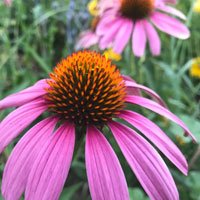
The Purple Coneflower or Echinacea purpurea, is an endemic perennial flowering plant that grows in North America. People know purple coneflower for its beautiful daisy-like purple flowers and for its medicinal use, which has also made it a must in many gardens and landscape worldwide. Resisting adversities, adapting to changing conditions, and serving as a crucial source of pollinators that include the bees, butterflies, and others, this plant draws positive attention of gardeners for its ornamental beauty and ecological significance.
Majestic Features of Purple Coneflower:
- Vivid Purple Flowers: Among our tallest and most vivid flowering plants, the Purple Coneflower’s bright purple flowers with distinctive orange-brown centers draw all attention to itself, beautifying gardens of all kinds.
- Long Bloom Period: This herb blooms during this time from midsummer to early autumn carrying the flowering period through the growing which ensures the supply of nectar and color to pollinators.
- Attracts Pollinators: Owing to growing appeal of butterflies and bees, as well as other common pollinators, Purple Coneflower becomes an integral planting in nature preservations or backyard garden that supports pollinators.
- Medicinal Uses: While its historical role in traditional, herbal medicine is immune-boosting, you will find that it is great to have, and it is useful for the holistic health of people. Therefore, there is need to maintain its existence in this world.
- Drought Tolerance: Purple Coneflower is able to sustain with less water once it is well-established. So, it becomes a perfect choice when one wants to pay attention to water saving and to dry climates.
User-Friendly Features of Purple Coneflower:
- Easy to Grow: The Purple Coneflower makes an ideal bloom option for any gardener. It adapts well to varying landscapes, including different soil types and growing conditions. This plant is suitable for seasoned gardeners as well as beginners.
- Low Maintenance: The good feature of this plant lays in the fact that it’s low-maintenance and once given the opportunity to settle down, it require much less care than some other plants used for the same purposes. Thus, it’s a perfect option for gardeners and garden low-maintained house.
- Longevity: Neatly taken care of, Purple Coneflower can be a long-lasting decoration, bringing a lot of satisfaction and enjoyment into the appealing presence of the garden.
- Versatile Use: The purple cone flower will do very well in borders, flower meadows, cottage gardens and wildlife gardens contributing visually to the setting alongside promoting biodiversity and ecological value.
- Deer Resistant: Purple Coneflower is resistant to deer, allowing this species to stand undamaged by their grazing in the garden, thereby minimizing the installation of protective measures and deterrents.
Irritating Features of Purple Coneflower:
- Susceptibility to Powdery Mildew: The Purple Coneflower may become infested by powdery mildew – a fungal disease, more likely to impact the plant’s lushness, thereby inhibiting its attractiveness.
- Limited Color Range: Although Soil Coneflower is offered in a broad selection of cultivars, the colors are predominantly restricted to different shades of purple and pink, according to the manufacturer.
- Seed Dispersal: Purple Coneflower can get out of control spreading and seeding with ease, because of good conditions, so there could be lots of seedlings showing up early and other plants in your garden might have to compete with.
- Spent Flower Heads: Ideally, the recovering flowers of Purple Coneflower will be trimmed off regularly to avoid creating an unpleasant shapeless look of the plant.
- Potential Flopping: Pump varieties of purple clover may become lanky and top-heavy, not only falling over during the flowering stage, but often rot at the base, as these do not get much air circulation.
Conclusion:
In the end, Purple Coneflower (Echinacea purpurea) is the perfect flower having all the positive qualities like aesthetics and functionality that the gardeners and landscape rely on. With its glorious location, this Purple Coneflower brings amazing scenery to garden by its purple flowers and the healing power for illness, as well as the pollinators, too. Despite the fact that it is susceptible to powdery mildew and harrowing irritations, the goodness of Purple Coneflower prevails making it a treasure of any garden, small or large, thus turning the spaces into the green paradise which we are very much happy about.
Catmint (Nepeta spp.):
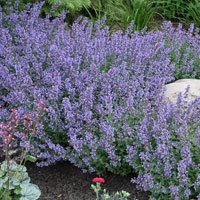
As a member of the Nepeta genus, Catmint belongs to the family of herbaceous perennials with wonderful fragrant herbs and rounded flowers. Native to Europe, Asia and Africa catmint has become a everywhere by cat lovers and garden scene is just perfect with its simple character and decorative traits. Catmint provides gardeners a wide choice of varieties and species, thus serving a diverse need of creating a calming space as well as having and ornamental garden that does not require much maintenance.
Majestic Features of Catmint:
- Fragrant Foliage: It will be such a wonderful sight every time you brush or blow on the fonds of the catmint’s foliage. The beautiful scent of mint will be all over the place!
- Abundant Blooms: During the whole span of a season, catmint grows robust flower clusters marked with colors of blue, lavender, pink or white as well as many pollinators, including bees and butterflies, visit the plant.
- Long Bloom Period: Catmint blooms are not only on display from the late spring to early summer, but they also last till into the fall coloring and fascination in the garden.
- Drought Tolerance: Adapted to the dry conditions, catmint does well in sunny places with well-drained soil, so it is surely the right pick for such low watering plants. This makes it very useful in water-wise gardens.
- Deer and Rabbit Resistant: Catmint is a repellent and hence rabbits and deer just pass from where the catmint is grown thereby reducing the risk for damage to other plants.
User-Friendly Features of Catmint:
- Easy to Grow: Catmint is a resilient and adaptable plant which is easy to be cared for, so the garden beginners and experts can both feel free to grow it.
- Low Water Needs: When already established, catmint is drought resistant and only needs occasional watering during hot spells or when the rain waters are scarce.
- Attracts Beneficial Insects: Besides honey-bees too, catmint is attractive to lady-bird insects and wasps that are predatory and that aid in pest management in gardens.
- Versatile Use: The beauty of catmint resides in its ability to adapt to different growing locations/sites such as flower beds, borderline gardens, rocky gardens, as well as containers, creating variety in the garden’s designs.
- Longevity: If a cat mace is properly cared for, it can lead a long life, giving you and your landscape a nice and bright view for several years.
Irritating Features of Catmint:
- Invasive Potential: Certain species of catmint can be problematic as they are invasive and readily spread if not kept under control. E.g. common catnip (Nepeta cataria) is one of the examples.
- Re-Seeding: Catmint may take over with the proclivity to self-seed profusely, resulting in undesirable seedlings showing up in the flowerbed.
- Pruning Needs: The powdery scent of catmint is thrived to ensure tidy looks as well as repeat blooming through regular pruning to remove tired flowers and prevent lanky growth.
- Attracts Cats: Although locals are often very much fond of catmint because of their cats, this attraction of stray cats from the vicinity can be a source of irritation to cat owners that do not want cats around their gardens.
- Susceptibility to Root Rot: Excessive wet soil conditions may result in root rot in catmint plants, especially when the soil has poor drainage or extended of frequent heavy rainfall.
Conclusion:
To sum up, Catmint (Nepeta spp.) presents a perfect choice for ornamenting any garden, with its unique mix of colorful trimmings, friendly aroma, and gentle buzzing of pollinators. With its glorious flowers, stress-relieving proprieties, and mildly annoying habits, catmint will remain popular forever among gardeners who love its fresh and bright outlook. The catmint fits in any kind of gardens, no matter if it is small backyard garden as well as special flowers gardens. Its attractiveness, fragrance, and resilience make it a valuable property and determining as per taste.
Russian Sage (Perovskia atriplicifolia):

Russian Sage as it is available in scientific community with a name Perovskia atriplicifolia is which stands out distinctly due dense silver-grey foliage came about in place of blue lavender blooms. Central Asia native Russian Sage also attracts gardeners that live in regions, where summers are hot and dry. With its amazing visual effect in a landscape, it is one of the nature’s best decorations. Its bushy growth habit, low water needs, and complementary roles in sunny borders, rock gardens, or perennial beds, make it an invaluable component of landscapes, decorating with not only texture but color and aroma as well.
Majestic Features of Russian Sage:
- Graceful Growth Habit: Russian Sage has a charming, erect posture with smooth stems going up, similar to the movement of grasses with a breeze, and thus, creating a dreamy appearance in the garden.
- Silver-Gray Foliage: The historical foliage of the Russian sage has a characteristic of a silver-gray color and dissected leaves, which are very delicate and provide a contrast with other kinds of green.
- Abundant Flowering: For a period that is approximately from midsummer to early fall, Russian Sage puts up an overwhelming outburst of fifteen to twenty five miniature, tubular lavender blue flowers and then creates a beautiful scene of color and texture.
- Pollinator Magnet: Fruity and colorful flowers of these plant species attract pollinating insects such as bees, butterflies, and hummingbirds. Therefore, planting Russian sage is sure to diversify and improve environmental sustainability in the gardens.
- Low Maintenance: Russian Sage may actually be a perfect match for homeowners with uneven schedules, as it is quite hassle-free and low-maintenance from the moment it is planted, making it the option of choice for drought-prone spots well.
User-Friendly Features of Russian Sage:
- Drought Tolerance: Not only used to hot and dry areas, but Russian Sage also demonstrate their efficiency as most sunny and well-draining soil wanted ones, therefore, they are an perfect option for water-wise gardening.
- Deer and Rabbit Resistant: Russian sage is one of the most resilient cultivars in gardens, since the browsing by deer and rabbits is not an issue, giving a long stand-alone show in the habitats where deer are abundant.
- Long Bloom Period: Front end of the Russian Sage blooming period begins in mid-summer and goes on the early fall thus leading to a long period of colorfulness.
- Easy Propagation: Russian sage produces cuttings from stem, and division, which can be used to further enhance this plant as also to allow sharing among gardeners.
- Versatile Use: Russian Sage would be a versatile garden plant that would fit smoothly into borders, clusters of mass plantings and mixed perennials for a balanced impact.
Irritating Features of Russian Sage:
- Invasive Potential: For some species, Russian Sage have been reported to be able to grow aggressively and spread seriously, and this can inhibit the spread of native species and disrupt the integrity of ecosystems.
- Leggy Growth: It may be doubtful that the Russian Sage will form a rainy growth, straight woody stems that will look unattractive in time without regular pruning.
- Root Spread: Russian Sage has a strong and deep root system, which may cause challenges in terms of removal or transplantation when already obtained a good position in the garden.
- Susceptibility to Powdery Mildew: Depending on the climate, Russian sage can be vulnerable to the occurrence of powdery mildew which is an earring a disease caused by a fungus, and it can lead to poor health and unsightly appearance of the plant.
- Intolerant of Wet Soil: Russian Sage chooses a soil form filled with sandy loam that does not become overly wet. Placing the plant in a soil which contains too much clay could cause root rot problems.
Conclusion:
As a conclusion, Russian Sage (Perovskia atriplicifolia) stands out from the crowd of perennials as a decorative and effective plant that contains various interesting features, user-friendly attributes, and occasional problems that gardeners need to take into account. This water-wise plant features cascading growth habit, drought tolerance and large flowering that bring color, texture, and fragrance to garden soundscapes, resulting in pollinators attraction and bio-diversity increase. Its invasiveness potential and periodic maintenance requirement may be the stumbling point in a few situations where this plant species is being promoted. However, it’s non-stop charm and good looks make it a vital and much desired ornamental in all types and sizes of gardens.
Overview of Lavender (Lavandula spp.):
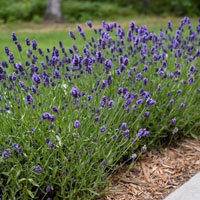
Lavender, one of the Lavandula genus representatives, remains one of most esteemed perennial herbs admired for its oily foliage which is characterized by captivating scents, eye-catching blooms and multiple uses. Having its roots in the Mediterranean area, lavender has won the hearts of gardeners and herbalists not only in Europe but around the globe for centuries from where it has gained a reputation for not only beauty but also pleasant fragrance and effectiveness in treatments. As it comes with many varying species and cultivars, lavender in general brings in an array of beautiful colors, sizes, and growth habits, and now, because of them, is certainly a desired plant for gardens, landscapes and even cooking process.
Majestic Features of Lavender:
- Fragrant Blooms: Lavender’s large, blooming clusters consist of colorful perfumy flowers varying in hues from deep purple to pale pink, as well as silvery white shades. This enchanting fragrance lures pollinators, offering passersby with a heavenly scented experience.
- Long-lasting Blooms: Lavender is a true light worker that blooms its blossoms all summer, which gives you room unlimited for cutting (drying) and culinary purposes also. This flower attracts bees, butterflies, and other helpful indigenous species to the garden.
- Drought Tolerance: Due to its tolerance of dry, sunny conditions, lavender is a proficient species, and it prefers well-drained soil. It can be considered an excellent alternative if one is looking for low-maintenance or water-wise gardening.
- Versatile Uses: Unlike other plants, lavender has a variety of uses such as flower bed ornamentation, spice, medicinal herbs, scent, and craft. With these, our gardens and homes will not only serve their purposes but beauty as well.
- Attractive Foliage: Lavender comes along with its beautiful blossoms and is also admired by gardeners for its aromatic foliage which entails its gray-green leaves, and in a way, the foliage is included among the favorite features that are found in flower gardens.
User-Friendly Features of Lavender:
- Easy to Grow: The lavender plant has great regeneration ability and also can thrive without extra care, thus this it is not a problem whether the gardener is an experienced or beginner.
- Deer and Rabbit Resistant: The dogs main repellent is its powerful smell and slightly bitter taste, especially for browsers. This makes it difficult for them to browse the garden and therefore, reduce the risk for plants from being injured.
- Adaptable Growth Habits: A lavender plant that has different sizes and growth patterns from compact mounds, upright spikes, and trailing stems exist. Therefore, it is a versatile plant usage on the day flow landscape, gardens, and containers.
- Longevity: If treated well, your lavender can live for years and when the next spring comes, your garden will be filled with the refreshing scent it gives out.
- Low Water Needs: As once the lavender is established, it is drought-tolerant thus, it will only demand watering in the case of dry spell, which smoking attracts it to arid climates and also makes it a good option for water-wise gardening acts.
Irritating Features of Lavender:
- Susceptibility to Root Rot: Just like the other lavender species, this plant is at high risk to root rot if soaked in poorly drained soil or overwatered, which causes the falling of its green shoots, stunted growth, and eventually killing of the lavender.
- Pruning Requirements: Lavender can often look informal and require trimming to keep a neatness aesthetic, promote denseness, and stop the stems from turning into woody stems causing leggy and unappealing appearances.
- Invasive Potential: As some lavender species are more aggressive in spreading such as Lavandula stoechas (Spanish lavender), they may become invasive and disrupt ecosystems by spreading aggressively. Consequently, they limit the selection of native species and native plants posing a danger to biodiversity and sustaining ecosystems.
- Winter Damage: winter damage may be the deal for lavender in regions with extreme winters and the survived plants normally are not perky in all parts, which can be solved if the plants are mulched in cold weather.
- Attracts Bees: A astonishing fact is that pollinators such as bees, which are attracted to lavender flowers might bother certain individuals due to its perception of an annoyance especially those with bee allergies and sensitivity.
Conclusion:
To sum up, among the cherished and multi-faceted perennial herbs, lavender (Lavandula spp.) features a plethora of outstanding qualities, possesses some user-friendly attributes, and might make gardeners suffer from occasional symptoms. Lavender with favorite perfume, being able to tolerate droughts, and usefulness for parks, gardens, and homes improve the lovely aesthetic, pleasant aroma, and functionality of spacing, thus making the outdoor spaces richer with the beauty of lavender. While its born weak to the root rot, the slipping-off, and the potential for the invasiveness raises the problems in some cases, the whole lavender will be appreciated by our green with the memories driving the development of the gardens of any size and style to bring people enjoy the beauty and the least can make their homes for the generations to come.
Bugleweed (Ajuga reptans):
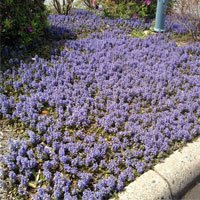
Ajuga reptans, or Bugleweed, is a diverse and hardy perennial with attractive and durable foliage, birthed flowers of varied color and adaptability to different growing conditions. Native to Europe, Bugleweed has gained a following among the gardeners who search for an easy to care and yet decorative plant to grow in the into the shadows or stabilize the slopes or play the leading role among other plants in garden beds. From its bushy growth with ability to colonize different soils, Bugleweed tends to be much ornamental and useful for the gardener, making it a good choice for a variety of gardens.
Majestic Features of Bugleweed:
- Colorful Foliage: Bugleweed offers leaf colors that stand out in a class, including green, bronze, burgundy, and variegated on a greenery background, thus providing a more interesting sight see.
- Spring Flowers: In the spring Bugleweed holds flower spikes of little pink, blue, purple and white tubular flowers which provide a carpet of new color. These attract foraging bees and butterflies therefore.
- Ground Cover: Bugleweed grows a big thicket of pennants that strangle the growth of weeds. These foliage mats, which proliferate on slopes, woodland gardens and other difficult areas, are very useful in preventing soil erosion.
- Shade Tolerance: With the ability to grow well in light conditions of half to full shade, the bugleweed will serve as a good planting companion for the trees’ shade, for shady walkways or in partly shadowed areas.
- Adaptable Growth Habit: The bugleweed is an extremely variable plant that may survive in many soil types and moisture levels, which may be dry and sandy, or as puggy as and moist as clayish soil, thus enabling it to handle many different types of gardens.
User-Friendly Features of Bugleweed:
- Low Maintenance: Bugleweed plant, comparatively, is of low maintenance and has the ability to live with less or no attention, thus arguably making it the most ideal choice for busy gardeners and zip landscapes.
- Fast Growth: The Creeping Bugleweed combats the weed problem through its creeping aspects of forming a dense ground cover that grows and fills in the bare spots with its own growth, eliminating the need for replanting and extra maintenance.
- Easy Propagation: Literally all it takes is a consecutive propagation of stem cuttings and division to propagate bugleweed for the gardeners, making them able to expand their plantings and fill in landscape voids without too much labor.
- Drought Tolerance: The easiest thing with Bugleweed is when it is growing, it can be drought-tolerant, and you do not need to give it any supplemental water personally. Therefore, this is the best choice as far as water wise gardening and dry climates are concerned.
- Deer Resistant: Bugleweed is known as a deer-resistant species, implying it is an less vulnerable target of browsing deer making it, in turn, less necessary to have deterrents or other protective measures against deer in the garden.
Irritating Features of Bugleweed:
- Invasive Potential: Lemon balm displays invasive behavior in some places, and it might grow aggressively, spreading across the landscape and overcrowding other plants, making the control of this weed problematic in the environment.
- Difficult to Remove: Establishment of the bugleweed is often a challenge to get rid of or extermination, as it spreads rhizomes and stolons that can quickly form new plants if partially or not totally removed.
- Limited Bloom Period: After Bugleweed flowers in the springtime, its flowering period is shorter than that of other plants that are considered perennials and allows for a shorter duration of colorful floral displays.
- Lack of Winter Interest: The leaves of bugleweed will often either fail to retain their green color throughout the winter or retreat from view completely as winter advances, only to regain their green color or present a less pleasing appearance in early spring.
- Potential Allergen: While most people do not face any skin issues when they come into contact with Bugleweed, there might be some individuals who encounter skin irritation or even allergic reactions when they handle the plant. This might be because they have sensitivities to some compounds in the plant or they might already be allergic to some other allergens.
Conclusion:
To sum up, the great charm of Bugleweed (Ajuga reptans) is that it is an all-around, hardy perennial ground cover providing both attractive ground cover and usefulness for gardeners and in landscape designs. Its edible foliage, found in fruit trees, offers practical value as well. Whether it is spring flowers, color, or adaptability to various growing conditions, Bugleweed adds toughness, diversity and beauty to gardens, slopes and shade areas. Although its invasive quality and annoying characteristics might be a problem for some gardeners, the varied advantages of Bugleweed contribute such a lot to gardens regardless of size and design and thus make them more attractive, enriched with its enduring charm and ground-covering abilities.
Hellebore (Helleborus spp.):
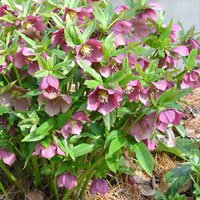
Hellebore, a common name for Helleborus genera, is a group of hardy perennial shrubs well known for their unique flowers showing first in spring and slowly emerging into the shade. Often referred to as Lenten rose but also Christmas rose, hellebores boast blooms of considerable duration as well as attractive foliage, making them striking and charming members of garden landscapes. Native to Europe and Asia, hellebores have a long-standing tradition with gardeners around the globe that appreciate their tenacity, amenable nature, and resilience under marginal growing conditions, making them a welcome, showy and colorful addition to shady gardens, woodland scenes, and perennial beds.
Majestic Features of Hellebore:
- Early Bloomers: Hellebores rank among the earliest flowers to come into bloom in late winter or early spring, as such the garden landscape craves color and interest at a time when few other plants have flowers.
- Variety of Colors: Hellebores boast of a broad range of colors which range from different shades of white, pink, green, purple, and even black. Gardeners can thus have a myriad of hues to pick from as they try to spruce up their garden landscapes.
- Long-lasting Flowers: The Hellebores blossoms are very persistent and are perfect for perennials ornamental because they enrich the garden with their beauty for a very long time, up to several weeks.
- Shade Tolerance: Hellebore flowers are known to be happy in and under the shaded environment (from partial to full) which make this plant a very good choice. The best places to plant them are under trees, along shaded pathways, or in other areas exposed to shade.
- Evergreen Foliage: Moreover, than half of hellebores have their leaves for the whole year long, decorated the garden landscape with green elements for all 4 seasons instead of only some of it.
User-Friendly Features of Hellebore:
- Low Maintenance: Hellebores produce flowers throughout the long months of winter and early spring which offer spectacular flowering display that can certainly last till late autumn. The plants do not demand for any maintenance but just to first ensure their survival the soil should be enriched with organic compost.
- Deer and Rabbit Resistant: Hellebores are not good food choices for deer or rabbits. So, it results in less trouble for the gardener that the plants will be left undamaged by these two browsing mammals and will not need special protective measures or deterrents.
- Drought Tolerance: Accordingly, after settling, hellebores become tolerable against drought and thus they don’t need much water if provided at all, hence are ideal for water-saving gardening as well dry climate.
- Long-lived: The good news is that when attention is paid to them, hellebores can remain in your garden for many years, rewarding you with substantial enjoyment and visual bliss throughout.
- Versatile Use: Hellebores are great for many garden settings, serving as shade gardens, woodland gardens, and mixed perennial borders which come with a variety of textures, shapes and colors heating up the landscape, generally.
Irritating Features of Hellebore:
- Toxicity: The toxic chemical found in the hellebores can cause surface of the skin to become irritated as well as upsetting the stomach if eaten. This means that eating a hellebore should be avoided and caution should be taken when working with them.
- Self-seeding: Some Helleborus species and forms have the effect of seeding themselves more than others and as such, become invasive if not controlled. The result is an invasion of gardens by variegated flowers. This spread could be prevented by careful control of seeds.
- Susceptibility to Leaf Spot: The disease leaf spot that is caused by fungi and characterized by the presence of spots on leaves, which appears in humid climates or during periods of long-lasting wet weather, making the foliage unsightly and plant weak.
- Limited Availability: In nurseries or garden centers, some Helleborus species and varieties which are not so popular, possibly can be a threat to gardeners searching particularly for them.
- Difficult to Transplant: Hellebores belong to the species that have very tall, thick roots hence relocating or transplanting once established takes a process that is delicate enough and requires that one is very careful so that the roots can be safely dig out and transplanted.
Conclusion:
In summary, Hellebore (Helleborus spp.) dies for us a stunning and practical perennial flower that is faithful for gardeners or landscaping fanatics. Starting their flowering in early spring, their shade resistance, and the long-lasting beauty of flowers bring elegance and charm into gardening hearts. However, much more, hellebores withstand the hardships of time and weather, merging the beauties through their lasting splendor. Despite its low-lying, somewhat toxic, self-seeding ability, and occasional degenerative disease, people continue to keep hellebores among their prized plants as their addition to gardens of all sizes and styles enhances the beauty and enjoyment of outdoor living spaces, which become a place to enjoy for generations to come.
Sedum (Sedum spp.):

Sedum, an ethnic group of bushy plants, is one of the largest, and most popular because of their resilience, versatility, and various ornamental species. These plants also referred to as sedums, is a treasured for their succulent (fleshy) foliage, bright flowers, and may grow well in different conditions. As to the fact that different species and cultivars are available, the succulent plants belonging to sedums provide gardeners with numerous possibilities of texturing, colouring and visualizing their garden landscapes, rock gardens, containers and green roofs.
Majestic Features of Sedum:
- Succulent Foliage: Sedums have fleshy leaves which store water and feature as succulent plants. This plant not only becomes water preserving but also stands out against drought conditions.
- Colorful Blooms: Sedums plants produce flower rosettes in different purple, pink, yellow, red, white and even bi-colors, which play host to helpful insect pollinators such as bees and butterflies.
- Seasonal Interest: Most sedum specie and cultivar give whole-year interest, as their leaves remain green and perennialize, providing texture and structure in the formal garden throughout the quiet of the winter.
- Drought Tolerance: Sedums are very drought resistant having a similar need for water, which means that they can even grow in very sunny and dry places. Together with other water wise plants they are perfect for the water wise gardening and xeriscaping
- Low Maintenance: Sedums are easy to care for plants, which demands only minimal management after the initial establishment, therefore excellent for gardeners who have little time to garden or those who are looking for uncomplicated landscaping.
User-Friendly Features of Sedum:
- Easy Propagation: Spreading sedums is simple because you can propagate stem cuttings and divide the plants with minimum hassle, helping more people to populate their gardens or bring a full look into the landscape only with a bit of effort.
- Versatile Use: Sedums find their place somewhere in any garden: rock gardens, containers, borders and even green roofs – they will give a decorated, beautiful and drought-resistant outlook.
- Deer Resistant: Many of sedums species resist by the chewing of deer, so that the plants may not be destroyed by browsing through the fences or keeping up the garden by deterring it.
- Attracts Beneficial Insects: Sedum blooms hither various advantageous insects, such as honeybees, butterflies, and hoverflies, which come as pollinators of your garden plants and pests’ controllers.
- Longevity: Sedum plants can perform well for longtime with proper care, and for gardeners, as it produces aesthetic enjoyment and beauty.
Irritating Features of Sedum:
- Invasive Potential: Sedum species, particularly the most intrusive – Sedum acre (golden sedum), spread aggressively if they are not kept under control, and eventually may replace native vegetation and disrupt the nature in an awful way.
- Susceptibility to Root Rot: The root disease, namely root rot, brought by the ephemeral nature of most (if not all) sedum species and susceptibility to poorly drained soils and overwatering, may manifest as yellowing/chlorosis and/or stunted growth, which will ultimately lead to decline.
- Leggy Growth: Failing to prune periodically, sedums may develop a leggy growth habit that shows up as long slender stems towering above for a long time.
- Re-Seeding: Growing some sedums may scatter their seeds to a great extent with the result of more population of such as unwanted seedlings in the garden and competing with other plants for resources.
- Winter Damage: In areas prone to severe winters, the heath of some of the sedum foliage may suffer damage which is caused when the temperature below the freezing point, leading to dieback of the plant and thus the original appearance will disappear till the spring and new growth will emerge again.
Conclusion:
As a result, the Sedum (Sedum spp.) genus proves to be multifunctional and highly adaptive to certain environmental situations, thus turning into a beautiful and practical group of plants for every gardener and the landscape. By planting sedums in living walls, containers, and green roofs, with their drought-resistant water requirements, juicy foliage, and colorful blooms they enrich and beautify all these types of recreational spaces with their consistency and endurance over time. Despite their invasive quality, susceptibility to root rot and higher than average maintenance, their positive traits like shade tolerance, drought resistance and self-sowing capabilities make them a prized plant widely grown in small or large gardens and garden styles, which helps sustain the aesthetic value of our living spaces.
Hosta (Hosta spp.):
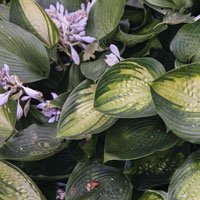
Hosta, being a plant from the hosta family, is a singular perennial that is well-admired for its abundant foliage, delicate flowers and shade-loving nature. In nature, they are called plantain lilies and valued for the diversity of form, from green and red through to variegated, as well as blue-toned leaf shapes and colors in gardens. They are native to East Asia, hostas have now become the irreplaceable part of gardens worldwide, spreading beauty shady borders, woodland settings, and containers with their graceful hardiness and ornamental features. Having multi-purpose, simplicity of care, and a capacity to grow in any kind of climate, hostas still are irreplaceable for people who try to create an eye-pleasing and vibrant garden.
Majestic Features of Hosta:
- Lush Foliage: The hosta is a slow-growing, compact plant with large leaves formed in crowns or rosettes, which may have a heart shape, or a lanceolate pattern and provide a lush, tropical look, to your garden.
- Varied Leaf Colors: Hostas are diverse in terms of leaf colors, including green shades, blue shades, yellow shades, and variety patterns, and this enables garden owners to select from a wide range of hues.
- Graceful Blooms: In the summer, the hostas send forth rather tall flower spikes that are very delicate and that come in colors like white, lilac, and/or purple, turning the garden into a charming and sophisticated place.
- Shade Tolerance: Hostas rank among the best specie for shade areas, be it a partial, full shade or a barking lane; thus, they make an ideal choice for planting under trees, along some shaded area or anywhere else where the sun is less available.
- Low Maintenance: Hostas can easily adapt to any garden without much care when planted, beginning wavers have an easy time planting them and experienced gardeners also acquire fast growing plants when they transplant them.
User-Friendly Features of Hosta:
- Easy to Grow: Hostas are rather easy to grow and amend well to diverse array of fancies and soil moisture levels, thus they fit well most of the garden locations.
- Versatile Use: Hostas can be planted in so many different garden settings, such as in the shade gardens or under the trees, on border lines or in containers, and bring gorgeous textures, colors and visual interests to the landscape.
- Deer Resistant: Besides, a lot of hosta species and subspecies also happen to be deer resistant that means they are not the deer’s favorite meals, and therefore, keep unhindered by acts of browsing by wildlife should be implemented in the garden.
- Longevity: Properly cared for, hosta plants can live for a long time, granting years of delight, as well as providing a verdant appeal to the garden scene.
- Disease Resistance: Hostas are relatively disease-free plants, with only a few important pests or diseases to watch out for; because of this, they can be seen as bankable variety by gardeners looking for a low-maintenance plant.
Irritating Features of Hosta:
- Slug and Snail Damage: Hosta plants are at risk of being eaten up by slugs or snails who favor to feed on plants leaves, causing the leaves to become riddled and disfigured with holes.
- Foliage Browning: Hostas leaves will look brown and dry out or scorch if they are exposed to too much sun light or hot conditions especially during the summer months in regions which have harsh summer heat.
- Dividing Requirements: As hosts age, they may become overcrowded resulting in an unhealthy and unable to thrive state which requires division to be a process that can sometimes be tedious and tiring.
- Limited Winter Interest: Hostas can display twiggy appearance or become colorless during the winter and the garden space may appear bare until the new growth makes an entry in spring.
- Invasive Potential: As for hosta species, they can be divided into two groups: native and foreign. Each category has its own invasive signs. If there is any kind of uncontrollable spread and plants like hosta plague the native vegetation their ecosystems will be disrupted.
Conclusion:
In summary, Hosta (Hosta spp.) acts as a popular and favorite perennial plant having both ornamental appearance and a handful of useful properties in our gardens and landscaping. Whether it is with their rich leafing, elegant flowers or shade tolerance, hostas liven and diversify the garden scenes due to their texture, color and visual interest, keeping the surroundings forever gorgeous and stable Though their vulnerability to slug damage, dividing requirements, and occasional invasiveness maybe a headache for gardeners, the multitude of advantages that hostas offer make them a beloved and treasured ornament in gardens of all sizes and designs, providing a sublime spot of serenity and tranquillity on outdoor living spaces, for years to come.
Coral Bells (Heuchera spp.):
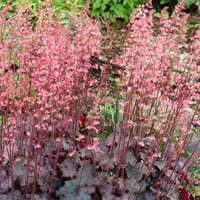
Coral Bells ( Heuchera spp. ) are a set of perennial flowering plants that come in various colorful foliage, tiny flowers, and good adaptability to create new landscape in the garden. From the North American local origin, Coral Bells have been a long-term choice of gardeners for the quality that they equally favour any growing condition from full sun to partial shades. From the broad leaf variety to the heavily textured ones, Coral Bells give gardeners choice of spectacular colors in leaf type and attire. This makes it highly suitable for borders and containers as well as for rock gardens and woodland settings.
Majestic Features of Coral Bells:
- Colorful Foliage: A type of flower that is widely known for its exquisite foliage is the Coral Bells. Those can be found in different hues of green, purple, red, bronze, silver, and so on. That creates permanent, admirable addition to designed landscapes.
- Delicate Flowers: In the spring and summer, Coral bells flower distinctively long rhododendron like spikes of delicate bell-shaped blossoms in shades of white, pink, or coral; attracting the attention of pollinators like bees and hummingbirds to the landscape.
- Compact Growth Habit: The growth habit of Coral Bells is mostly compact, formed inside of neat little tan undulations that add enough texture and color to garden beds and borders at the same time.
- Long-lasting Foliage: This is because the dwarf forms Coral Bells have either evergreen or semi-evergreen leaves which will retain them looking good for 12 months a year, allowing them to keep bringing you color and structure in the garden all year long.
- Versatile Use: Coral Bells have numerous application possibilities. These include use of them as a boundary plant, rock garden decoration or in containers, as well as woodland garden decoration. The offer fresh, vivid color and give a spatial dimension to your garden.
User-Friendly Features of Coral Bells:
- Low Maintenance: Few plants need less care than Coral Bells; just enough to thrive once established in the garden. They suit gardeners who have little time and effort to give to the garden, low-maintenance landscapes
- Drought Tolerance: Establishing coral bells is drought resistant and you only need to run supplements during hard times, not during dry weather or dry area.
- Deer Resistant: Some varieties of Coral Bells are not much attractive to the deer, therefore there is less chance for them to be eaten by these wild animals, and, as consequence, gardeners do not need to take extra cautions against those or to deter them.
- Easy Propagation: Coral Bells have the knack for being propagated through stem cuttings or by dividing them; so, it is also worth sharing these plants for they’re worth noting.
- Adaptable to Various Conditions: Coral Bells plant can grow on both the sandy and more acidic soil, with variation from well-drained to moderate moisture. Consequently, this perennial will be suitable for a variety of gardens.
Irritating Features of Coral Bells:
- Susceptibility to Root Rot: While the Coral Bells is generally a strong and resilient plant, root rot may develop if planted in a ground pooled with water or over-watered, as it is typical with yellowed foliage, stunted growth, and decline.
- Limited Bloom Period: Even though the Coral Bells are considered the most attractive flowers that grow in the spring and summer season, their blooming time is just only short-lived, hence they get less or no prolonged interest compared to other perennial plants.
- Foliage Fading: The look of Coral Bells can deteriorate or fade due to just one factor – such as the sun’s excessive rays or summer’s heat, and particularly hot, dry conditions.
- Vulnerability to Crown Rot: Coral Bells are very sensitive to crown rotting if the crown went under the soil too deep or when the soil around the crown permanently remains constantly wet, which will cause the base the plant to rot and eventually die.
- Limited Winter Interest: Some Coral Bells varieties can send their leaves home during the winter period, which can turn the landscape of the garden into the bare result until a new growing season arrives.
Conclusion:
To conclude, Coral bells (Heuchera spp.) have proven to be a very diverse group of evergreen perennials that can serve both as beautiful ornamental plants and as practical tools in gardens and landscapes around the world. This variety of plant with its bright colors, attractive flowers and low demands on maintenance just adds some texture, color and visual interest to garden landscapes and therefore as they continue to persist in the outdoors, they are making them more beautiful, and they are resistant to stress and harsh weather conditions. Despite certain diseases susceptibility, short blooming season and probably the fading leaves, the overall benefits of the Coral Bells make it a beloved and awarded addition to gardens of any size and style, helping to make every outdoor site beautiful and enjoyable for years to come.
Bee Balm (Monarda spp.):
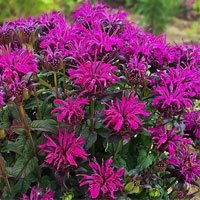
Bee Balm or Monarda spp. is a marvelous ornamental flowering plant that comprises a collection of bright and fragrant plants which attracts pollinators such as bees, butterflies, and hummingbirds. A genus of the Labiatae family, Bee Balm, originally native to North America, is now beloved to gardeners who appreciate its sturdiness, adaptability to different locations, and ornamental nature. The uniqueness of Bee Balm lies in the offering unusual range of flowers that appeals to gardeners of all tastes. This provides them with a varied selection of species and cultivars by flower colors, heights and growth habits, which ensure it becomes a lively addition to perennial borders, a comfy cottage garden or a wildflower meadow.
Majestic Features of Bee Balm:
- Vibrant Blooms: Bee Balm generally produces flowery clusters in shades of red, pink, purple or white thus, the display of color is very vibrant, and lesson adds a wide range of choice for pollinators as they are attracted by array of colors. Even more, it adds visual interest to the garden landscape.
- Long Bloom Period: Most Bee Balm species have a prolonged bloom period that starts in early summer and lasts up to late summer. Consequently, these plants provide a constant supply of nectar and pollen for pollinators which have high demands during this period of the season.
- Aromatic Foliage: Bee Balm, boasting its fragrant leaves, that upon being crushed or touched unleashed the lovely fragrance to onlookers, flaunting the garden with an appealing state.
- Attracts Pollinators: Bee Balm flowers are remarkable by their intense appeal to bees, butterflies and hummingbirds that they are the pivotal plant for pollinator-oriented gardens and ecosystems.
- Medicinal Uses: A few species of Bee balm have some medicinal properties, being utilized in traditional medicine for the treatment of the common cold, seasonal fever and digestive problems.
User-Friendly Features of Bee Balm:
- Easy to Grow: Coming out of the bag, Bee Balm is resistant to normal soil and pH conditions, making it a good flier pick for both newbies and old-timers alike.
- Low Maintenance: The Bee Balm is a pocket-size plant which receives minimal care and once established is suitable for busy gardeners and simple landscape designs.
- Drought Tolerance: After the initial establishment, Bee Balm becomes impervious to drought conditions and requires little to no added watering, thus, it is a good water-smart move to plant Bee Balm in landscaping practices.
- Deer Resistant: Edible Bee Balm flowers are covered with fluffy hairs that make them the bane of targeted deer, hence lessening the need to fence-in or use deterrents in gardening.
- Versatile Use: Bee Balm, which can be used in bordered gardens, meadowlands of wildflowers, a cottage garden, or a pollinator friendly landscape and will be a beautiful decoration while maintaining ecological value in your garden.
Irritating Features of Bee Balm:
- Susceptibility to Powdery Mildew: Powdery mildew, a fungal disease, could affect Bee Balm by causing its leaves to be covered with fine white powder, which not only curbs their beauty, but also hampers their growth.
- Aggressive Spread: It should be noted that some Bee Balm species tend to be zestful and invade surrounding plants via disease-proofing roots leading to the creation of a thick layer which is impossible to uproot.
- Limited Color Options: While the flowers of Bee Balm are of different colors, including red, pink, purple, and white, this can be not as many as the range of colors that is available for other perennial flowers which are flowering.
- Prone to Flopping: Taller grown cultivars of Bee Balm may become top-heavy pushed off balance thereby their beauty is destroyed, not unless they are staked or supported as this will lead to their natural display.
- Self-Seeding: Bee Balm could happen to spread in a undesirable way under favorable growing conditions and self-seed prolifically, and in so doing, it might gather the urge to do so.
Conclusion:
Ultimately, Pimpinella anisuim (Monarda spp.) becomes a favorite and multipurpose flowering plant that provides people with both decorative charms and ecological benefits. Its showy flowers, its arrestingly smell and its attractiveness to beneficial insects, Bee Balm flowers add colors, fragrance, and biodiversity to landscapes, making them enriched with colors, fragrant and full of biodiversity, welcoming plants, and insects. The resistance of Bee Balm to powdery mildew, its tendency to spread and occasionally flop call not only for a commitment of many gardeners to managing that, but also for a commitment to the overall triumph of Bee Balm in the gardens of all sizes and styles, thus making them more beautiful and ecologically functional for ages.
Grand Conclusion:
In a nutshell, the perennial purple leaf plants are a brilliant show of art, plasticity, and strength to the world. These plants are the real artists who paint the beautiful pictures to nature’s palette. After all, they have the majestic hues of their foliage and the enchanting appeal of their blooms. As we’ve explored their majestic features, user-friendly qualities, and even their occasional irritations, one thing remains abundantly clear: perpetual purple leaf plants not only provide a stunning backbone to any garden, but my, my! What true artwork these shapes of nature are and such a pleasure it is to see a person’s eyes light with amazement at them. Thus, let’s admire them for what they bring, enhance their enchant and keep on study the unlimited potential they keep in creating extraordinary, striking places that will impact everyone who saw them.

